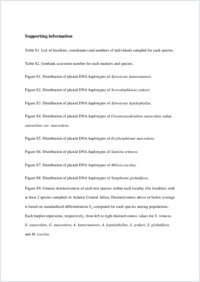Congruent phylogeographical patterns of eight tree species in Atlantic Central Africa provide insights into the past dynamics of forest cover
- Dauby, G. Faculté des Sciences, Evolutionary Biology and Ecology, Université Libre de Bruxelles, Belgium
- Duminil, J. Faculté des Sciences, Evolutionary Biology and Ecology, Université Libre de Bruxelles, Belgium - Sub Regional Office for Central Africa, Bioversity International, Forest Genetic Resources Programme, Yaoundé, Cameroon
- Heuertz, Myriam Faculté des Sciences, Evolutionary Biology and Ecology, Université Libre de Bruxelles, Belgium - Forest Ecology and Genetics, INIA Forest Research Centre, Madrid, Spain - Department of Biology, Unit Ecology and Evolution, Université de Fribourg, Switzerland
- Koffi, G. K. Faculté des Sciences, Evolutionary Biology and Ecology, Université Libre de Bruxelles, Belgium - UFR Sciences de la Nature, Université Nangui Abrogoua, Abidjan, Ivory Coast
- Stévart, T. Africa and Madagascar Department, Missouri Botanical Garden, St. Louis, USA - Herbarium et Bibliothèque de Botanique africaine, Université Libre de Bruxelles, Belgium - National Botanic Garden of Belgium, Domein van Bouchout, Meise, Belgium
- Hardy, Olivier J. Faculté des Sciences, Evolutionary Biology and Ecology, Université Libre de Bruxelles, Belgium
-
01.05.2014
Published in:
- Molecular Ecology. - 2014, vol. 23, no. 9, p. 2299–2312
English
Cycles of Quaternary climatic change are assumed to be major drivers of African rainforest dynamics and evolution. However, most hypotheses on past vegetation dynamics relied on palaeobotanical records, an approach lacking spatial resolution, and on current patterns of species diversity and endemism, an approach confounding history and environmental determinism. In this context, a comparative phylogeographical study of rainforest species represents a complementary approach because Pleistocene climatic fluctuations may have left interpretable signatures in the patterns of genetic diversity within species. Using 1274 plastid DNA sequences from eight tree species (Afrostyrax kamerunensis, A. lepidophyllus, Erythrophleum suaveolens, Greenwayodendron suaveolens, Milicia excelsa, Santiria trimera, Scorodophloeus zenkeri and Symphonia globulifera) sampled in 50 populations of Atlantic Central Africa (ACA), we averaged divergence across species to produce the first map of the region synthesizing genetic distinctiveness and standardized divergence within and among localities. Significant congruence in divergence was detected mostly among five of the eight species and was stronger in the northern ACA. This pattern is compatible with a scenario of past forest fragmentation and recolonization whereby forests from eastern Cameroon and northeastern Gabon would have been more affected by past climatic change than those of western Cameroon (where one or more refugia would have occurred). By contrast, southern ACA (Gabon) displayed low congruence among species that may reflect less drastic past forest fragmentation or a more complex history of vegetation changes. Finally, we also highlight the potential impact of current environmental barriers on spatial genetic structures.
- Faculty
- Faculté des sciences et de médecine
- Department
- Département de Biologie
- Language
-
- English
- Classification
- Biological sciences
- License
-
License undefined
- Identifiers
-
- RERO DOC 209896
- DOI 10.1111/mec.12724
- Persistent URL
- https://folia.unifr.ch/unifr/documents/303553
Other files
Statistics
Document views: 153
File downloads:
- pdf: 228
- Supplementary material: 185

